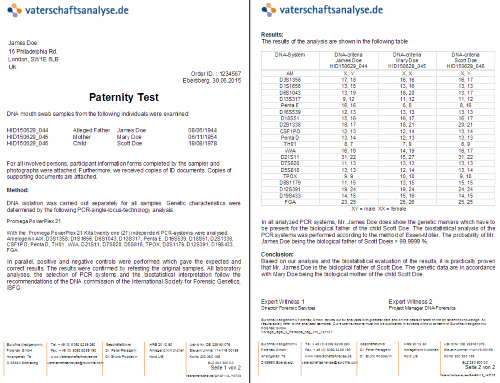DNA Report


004915156425656
What is a DNA test report?
The results of a paternity test report, also DNA report or parentage report, gives evidence regarding the alleged family relationship.
In a parentage analysis we test your DNA samples in order to find correspondences within the DNA of the participants. Each person of course has a unique DNA profil. It is by one half received from the mother and by the other from the father. There are minor variations within the DNA of each person that are useful for DNA tests. When we have tested your DNA samples and written a DNA report these reports clearly show these variations or their absence. Hence, we can establish or rule out certain parallelisms between the different reports and therefore also specify a relationship between the test participants.
Our DNA reports will always be according to the current German law and medical standards. The reports are court approved. If you intent to use the report in court we suggest to discuss this with the judge beforehand.
What age should a child be to perform a DNA paternity test?
A newborn baby can already be tested. The samples for our paternity test are taken with a simple buccal swap. This is not traumatic for a baby.You only need to take care not to use the swab directly after the baby has been fed. Please allow about 30 minutes to pass after the last feed. Like this, maternal DNA may not contaminate the child's DNA.
Prenatal paternity tests are forbidden according to the law. You may read more about this on our dedicated webpage.
Result: Paternity practically proven
In a DNA paternity test as well as in a DNA relationship test, we compare the genetic profile of the participants to determine whether or not the participants are related. This is done by a comparison of the DNA markers.
For a paternity test our laboratory will test at least 21 DNA markers to determine the paternity. If there is a chance that the two alleged fathers are related you need to let us know beforehand. Additional analyses need to be performed and it will determine the way we interpret the test results.
For a relationship test we will use a more comprehensive test as the participants are often only distant relative, if related at all. So we will test 26 - 45 marker, if needed even more that that, to answer the question of relationship between the participants.
If, after the testing, we cannot exclude the paternity for an alleged father we will proceed with a biostatistical probability calculation. This way we will prove a paternity probability of >99,9% in a deficiency case. Such a result is called "paternity practically proven".
If the mother will take part in the DNA test the statistical result of probability can be increased to 99,999%.
Result: Paternity excluded
If there are genetic markers in the child's DNA profile which cannot be found in the alleged father's profile, this person is excluded from being the biological father of this child.
For a paternity test with two or three participants we generally test 21 to 31 DNA markers. The child's inherits half it's DNA from the mother and the other half from the father. If the mother and the alleged father are the approved parents of the child the DNA must have been inherited from those parents. A paternity test now analyses the DNA sequences. When, during the test, we find differences in 3 or more DNA markers the alleged father's paternity is excluded.
An exclusion will always be 100% secure. There is no "maybe". Should we come to this conclusion after our first analyses we repeat the whole test for free with the second sample you have submitted.
What does a DNA Report by VaterschaftsAnalyse.de look like?
Here you see a copy of a positive paternity test result so you may have an impression of what a DNA report will look like and what kind information we will give.
Example of DNA report (PDF)


